Since there are a lot of options on the broad market for .22 pistols it can be a daunting challenge to find the best .22 pistol. Look no further than this list. It’s here that you will find best in class .22 pistols that you can be happy with.
But it’s not as simple as just choosing a brand name or a specific style. To get to the final options on this list of the best .22 pistols, we had to evaluate hundreds of options.
We also think it’s important to quantify how one might use these pistols and which specific characteristics are desirable in certain common shooting situations.
The preamble to the list of the best .22’s, offers some of this stage setting, to get you into the flow of understanding where we were coming from when creating this highly curated list of firearms.
We won’t bore you with the details of subtle differences in cartridges among the wide spectrum of the .22 range. We won’t try to force you into a specific type of gun or favor a specific manufacturer. While it is true that certain manufacturers have an affinity towards the .22 pistol, or a particularly good set of options, there are many manufacturers that make great pistols in the .22 caliber.
We tried to be diverse without diluting the pool of potential best in class .22 pistols.
Best .22 Pistols
Ruger Mark IV Target
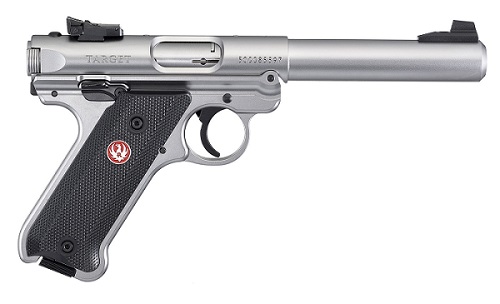
The Ruger Mark 4 is perhaps the best pistol Ruger has ever made. That’s clearly a strong statement, considering Ruger is an iconic brand with several blockbuster pistols to accompany their legendary rifles like the 10-22.
This is a longstanding firearm. It’s been part of the Ruger lineup for decades. It is also a firearm that can last for, conservatively, many hundreds of thousands of rounds with minimal maintenance beyond routine cleaning, etc.
This author has seen a gun used for range rentals that has shot more than 1.5 million rounds and has only had a handful of parts needing replacement. It’s not as accurate as it once was, but only slightly less so. It’s not as tightly fitting as it once was, but only slightly less so. It’s every bit as fun to shoot and reliable, as long as it is clean – as it always has been. This is a profoundly important characteristic for a firearm in the .22 pistol market.
People shoot a lot with .22 Pistols. The ammunition is inexpensive, and the guns are fun to shoot. The Ruger is an unbelievably durable and reliable pistol.
There are many iterations available, and by no means do you need to pick this particular model. However, this variant is a nice option with the good overall balance and size. The 5.5 inch barrel is very accurate, with the bull barrel profile and the adjustable iron sights providing a stable, long sight plane without making the shooting part of the equation a chore. It’s lightweight (2.65 lbs.) but still substantial and extremely well-balanced.
The classic lines of the Ruger MKIV are reminiscent of the Luger, but also have some 1911 styling cues. The controls are all within easy reach and the magazines are built to a standard that is basically unheard of. For a .22 Pistol these are among the best magazines ever made.
On a whole, it is hard to pick anything that is poorly designed or built; it is truly a well thought out, proven and optimized .22 pistol.
Pros:
- High potential for customization
- Proven on so many levels
- Unbelievable durability and reliability
Cons:
- No real Cons
Best use: Target Shooting, Plinking and general fun
Ruger – Bearcat
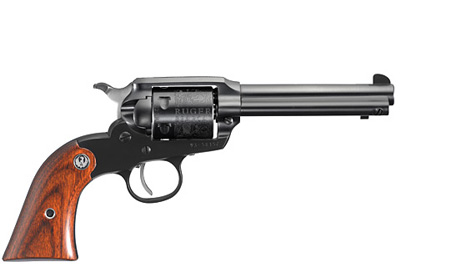
This is a modern-day throwback to the original Single Action Revolver, and very specifically the Colt Single Action Army. It is a beautifully made version, and it offers a legacy quality revolver that you’ll enjoy shooting for years and decades and beyond.
The quality of fit and finish is impeccable. The maintenance requirements are low, and because of such good quality in manufacture, it is a much easier process.
The trigger pull and the internal fitment are excellent. The trigger breaks like glass, as a properly built SA Revolver should, and the hammer actuation and cylinder movement and mechanisms are well tuned. This level of tolerance and fitment is virtually unheard of in cheaper revolvers. Yes, the price point is higher than many competitors, but this is a list of best in class 22 pistols – this gun, is without question, a best in class.
A four-inch barrel keeps the gun accurate enough, though the sights of the style of gun that this is modeled after aren’t as precision as some other competitors. You probably wouldn’t use this over a gun with more adjustable or better sights for target purposes, but that’s not the ideal use case for the gun.
It’s meant for lovers of the platform, and it is built for long-term fun shooting. The fact that you can hit the X-Ring means that Ruger has excelled in the building of it.
The overall weight of 1.5 lbs. and the compact size of only an 8.8″ overall length means any shooter can handle it easily.
It’s a pretty looking gun with historical context; that has lines everyone can appreciate.
Pros:
- A simple and easy to understand gun
- Pretty lines and comfortable to use
- Meticulous fit and finish
Cons:
- It’s pricey for a .22LR (though it costs the same to produce as any other caliber for the same style of gun)
Best use: Long range days with new shooters or traditionalists who like the single action army
Glock G44 .22LR Compact Pistol
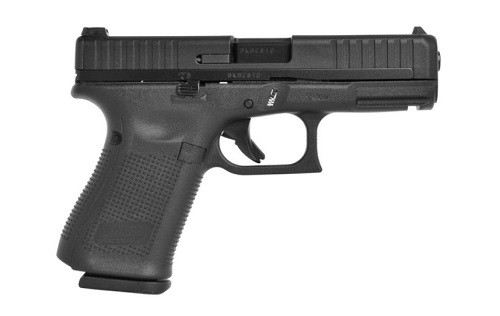
A Glock in .22LR. Brilliant if they can pull it off and produce a reliable firearm in a normal sized form factor. Well they pulled it off. The G44 is reliable, easy to use and functions almost exactly like any other Glock with the exception of a lighter slide weight and a minimized spring tension on the slide.
This is a game changer! If you are already in love with the Glock concept, the G44 is a must have. It is close enough to the actual function of your normal firearm from within the Glock family of pistols, but this is the best .22 pistol in the form of the regular full power firearms by any manufacturer with the only legitimate competition being the Beretta 92 rimfire.
The ability to digest any type of ammunition in the .22LR cartridge means this is a legitimate offering from a company that rarely gets reliability wrong. The opportunity for training on a substantially similar gun to what you are already using means you are getting extra practice for pennies on the dollar at the range.
It’s functionally excellent. The only drawback is that the necessary slide weight means you cannot use it with existing optics unless you are using very hot rounds and even then, the reliability can suffer a small amount. This is true of any .22LR variant of a normal sized gun because the slide must be balanced on the tiny amount of recoil created by the round. This still doesn’t pose a problem at this time for very many shooters.
There is a 4 inch barrel and its made to the new standard which includes the Glock “Marksman” build.
It’s accurate, easy to use, lightweight and fits most people hands regardless of size.
Pros:
- Extremely reliable
- Proven design that allows you to train with a substantially similar gun as your normal firearm
- Lightweight
Cons:
- No option for optics because of low weight slide (at the current time)
Best use: for additional training on a similar style firearm
Beretta M9 .22LR
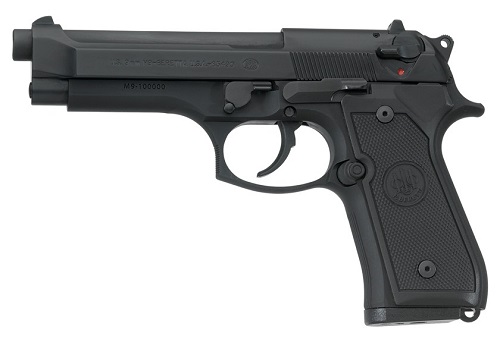
This is a very well-made firearm. The fact that it is so similar to the original firearm makes it a perfect training companion to any user of the 92/M9 Beretta.
It’s also heavily built. Meaning you aren’t shooting a gun that is half the weight of the original.
The real 92 weighs about 35 ounces or so depending on the variant. This is a 26-ounce firearm. You are only feeling a little more than half a pound difference. This is important as you train. It’s helpful, because it’s lighter weight and lower recoil, therefore you can shoot more in training sessions. But it’s also not so different than the original that it’s not a reasonable facsimile.
It’s not a striker fired polymer gun. So, it adds some helpful features for traditionalists. The decocker is helpful and adds some safety for most shooters. The controls are reversible to allow for ambidextrous shooting. The sights are fixed but built better than just about any striker fired polymer variant.
A 4.9-inch barrel is slightly smaller than the new M9, but offers a very similar feel and look. The aesthetic is very close to the new variant and identical to the original M9. The pistol is also extremely accurate and built to be a standalone .22 pistol. This is a very good build from the company. The ability to treat it as its own platform means you get attention to detail you might not get in a product that is simply a component change. The balance is excellent. Perhaps better than the original M9.
A physical external hammer and a DA/SA trigger is a holdover that offers a traditional feel and excellent safety considerations.
Pros:
- Very similar to the M9/92 – perfect for additional training
- Very comfortable and easy to shoot
- Good looking
- Proven design
Cons:
- Magazines aren’t as plentiful as other models on the market
Best use: additional training for the M9/92 Beretta firearm. New users who want something approachable and functional with a full sized build.
Smith & Wesson – 617
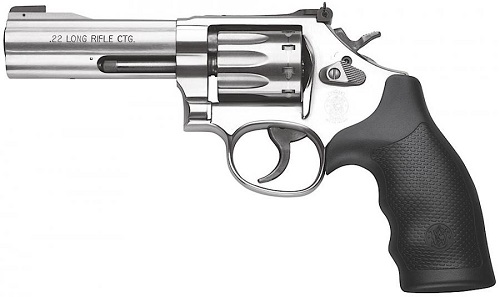
A beautiful 22LR revolver that has set the standard across the entire market for a very long time. It’s based on the K-Frame so it’s not a flimsy little pistol. It’s made with heft and weight, durable construction and the same features as a full power variant. The sights and grips, trigger and hammer are all the same.
That allows you to train with much cheaper ammunition, and much less recoil. This is one of the best newcomer’s guns on the market. It is such a well-made model, and offers the same looks, feel and balance as it’s bigger brother.
This is a nearly 3 lb. gun. It is not a toy. Many .22’s are built like toys, as though the gun shouldn’t be used by sophisticated, experienced shooters. That is not the case with this revolver. But you do pay a price for the added heft and weight. It’s nearly as expensive as the other K frame guns. It should be, too, as it costs every bit as much to produce. Smith & Wesson knows that it cannot undercut pricing because it’s a standalone, no-corners-cut model.
The 6-inch barrel is substantial. It offers a long sight plane and the adjustable sights are proven on S&W models for decades. The trigger feels crisp and smooth from factory. It is also a pistol that can accept a lot of aftermarket options.
If you need a super close copy of your favorite firearm, this is an excellent choice.
Pros:
- Good for hunting, with great reliability and easy to understand operation
- Excellent gun for new shooters
- Great target options and accuracy
Cons:
- Pricey
Best use: Target Shooting & Hunting of small game
Walther – PPK/S
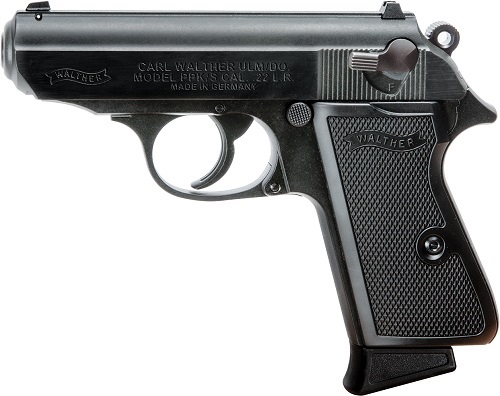
Walther is a company that was built on the back of small carry firearms with lightweight functionality that could be carried easily. While it’s true that the .22LR hasn’t been the popular caliber for the PPK, it’s also the one that many covet.
This is an elegant, reliable and proven firearm that’s been in production for a very long time. It is also a famous platform because it’s been so well made straight from factory for so long. The tolerances and manufacturing controls are top of the market. The looks are classic and stunning. The accuracy and feel in the hand are sublime.
Iconic and proven, this is the gun that James Bond always uses, just in a smaller caliber variant.
The beautiful and durable nickel finish allows easy maintenance and classic good looks without being overtly flashy.
An overall length of only 6.06″ means this is a perfect carry firearm, as a first or a backup.
A 3.35 inch barrel gives enough length to grab extra velocity but not so much that you lose carry capabilities. The accuracy is high, even though it’s a short barrel and a small frame. The magazines are proven reliable and the gun will digest most ammunition across the .22LR spectrum.
Pros:
- Iconic
- Legacy quality build
- Easy maintenance
- Spectacular magazines
- Very reliable and accurate in defensive scenarios
Cons:
- No real Cons
Best use: smaller shooters who need a reliable backup or frontline carry firearm.
Volquartsen – Scorpion 22 WMR
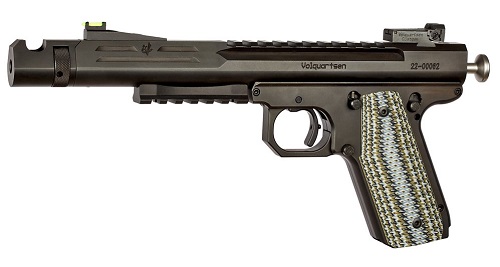
Ordinarily we would have chosen something like the PMR by Kel-Tec, which was the defacto .22WMR semi-auto on the market. It was inexpensive and pretty durable, well made, etc. But ultimately there have been some problems with the gun from basic reliability issues at times, to the more difficult problems to solve – production capacity to meet demand and basic quality control issues.
Unfortunately for the PMR-30, if you need a fully reliable gun you can get now, in a semi-auto .22WMR chambering, this is the one you should be looking at. Ordinarily we wouldn’t put such an expensive gun on the list, or one which is essentially made to order, because it’s not as mainstream as it should be for a round-up type article like this one.
However, Volquartsen isn’t just some random gunsmith custom production facility. It’s a full-fledged production team now, and this is a proven entity that shows excellent reliability and potent capabilities from a ballistic and performance perspective.
The Volquartsen Scorpion .22WMR is the real deal. It is well made and despite being pricey, it offers very good value for the spend. Yes, it is a $2000 .22 pistol. Yes, we still think it is a value-driven pistol.
This is made as a custom/semi-custom build to order type firearm. This gun is also held in stock by companies like Brownells. Generally, the pricing is better in this model, because it guarantees sales for the manufacturer, while allowing customers to access guns immediately. It’s a win-win for both sides of the buying equation.
The overall build is probably more than most shooters will need for the gun. It’s made to an extremely high level of precision and has a lot of add-ons and can be highly accessorized. Volquartsen has made its name building platforms like this and the parts that plug into the ecosystem.
Here you are getting a 10 round .22 Magnum pistol that actually can function without reliability issues. This is incredibly important. As a feature set, if this was the only feature, it’s enough to sell thousands of guns.
But this isn’t the only feature in the feature set. It’s incredibly important though. Most manufacturers cannot get around issues of bolt slam, speed of mechanics in the top end of the semi-auto platform with the .22 WMR. This is because the cartridge is so fast and powerful, but also has a tiny projectile and a rim on the cartridge.
That combination makes for a very difficult to produce gun. The inconsistency of rimfire ammunition and the combination of a fast-moving projectile that needs to utilize a spring driven and recoil operated actuation is too much to overcome simply with balancing of weight and spring tension.
There has to be a third factor to harmonize the reliability and the underlying cyclic rate. Most manufacturers cannot figure this out for a mainstream firearm. Volquartsen has.
Their design doesn’t have to move a full slide. It has a bolt that cycles within the slide. Furthermore, it has a robust muzzle compensator. This combination allows a measurable improvement in evening out the velocity and reaction to projectile exit and allows much better stabilization of performance. Hence it has a better reliability factor.
It does have other benefits too, with excellent sights including a tritium rear and a Hi-Viz front. It’s heavy, so recoil is mitigated between the compensator at the muzzle and the heavy weight. It is also highly accurized. The solid frame and the fit to upper end means you get extreme accuracy. Rails on top and bottom allow good optics customization and the 6 inch barrel adds a long sight plane and higher velocity potentials.
The round itself offers potent small game hunting ballistics. You can do it all with this one, including defensive needs (though it’s not a carry gun) and target shooting. Ultimately this is a hunting gun made for great range variability and allows for optics you cannot mount on other .22 pistols because of the build quality and the inherent accuracy, as well as the solid rails.
Pros:
- Seriously accurate
- A proven builder even if the volume of production guns is still at the boutique level
- Heavy ballistics for a rimfire
- Well appointed
Cons:
- Pricey
Best use: hunting for larger animals than squirrel
Browning 1911-22
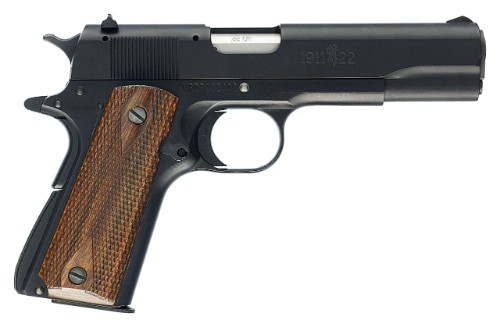
It’s interesting that Browning, the company named for the 1911’s designer, doesn’t have traditional 1911’s in their product portfolio. Especially considering that the market is overrun with makers that copy the original 1911 design. Where Browning has chosen to connect to the consumer with the 1911 style is in the rimfire space *(the company is also producing a .380 ACP model).
Browning guns in their current manufacturing scenario are very high-quality guns, as they always have been. But the company knows that they cannot compete with so many other makers in the larger calibers like .45, 10mm and 9mm, etc.
Kimber, Sig, Wilson, and countless others offer premium quality variants at prices that coincide with the amount of work put into them at the factory. It’s a very flooded market.
Browning can, however, give all the attention needed to build a standalone sub brand with the 1911’s in less traditional cartridges. It is producing very good looking, reliable and high quality 1911’s in smaller calibers and they are hitting the middle market price point. It’s a nice place for the company to add revenue. But they earn it with offerings like this one.
This is, first and foremost, a beautiful and reliable firearm. As a .22 pistol, it is surely a best in class.
The size is right, but it’s built for the caliber, it is about 20% smaller than the full sized 1911. For this cartridge it just makes sense. The ergonomics are still superior even with the smaller size. The pistol weighs 15 ounces and is easily handled because of the mild recoil and the nice size for a large part of the shooting community.
It holds 10 rounds of .22LR and offers a 4.25″ barrel, and excellent iron sights. The combination makes it easy to get on target and the low recoil makes follow up shots fast and accurate as well. The overall performance is top tier and the accuracy is also in the top 5% of the market.
Pros:
- Gorgeous
- Made to a very high standard
- Proven reliable and accurate
- Good price point for the value delivered
Cons:
- Not a full-sized frame – this could bother some shooters who want a true size facsimile
Best use: Target shooting where accuracy is exceptionally important
The different .22 Rimfire Options
There are a lot of .22’s on the market. Most of them, and a vast majority on this list are applicable to the .22LR cartridge. This is an extremely popular cartridge because they are easy and inexpensive to manufacture, and they have a longstanding position as a popular round. Furthermore, the guns that utilize this format/cartridge have very little work to do to achieve reliability.
The cartridge itself is quite versatile. And that doesn’t just apply to its ability to work with a vast array of mechanisms and styles, but also applies to the fact that it can be used for a wide variety of things.
Below we think a precursory explanation of those activities and how the guns we chose match up characteristically to the best-chosen characteristics of that style of use case, is important.
That is to say: most of you reading are already familiar with the .22 pistol world. And yet, we think you could benefit from reading the next section instead of skipping past it to get to the list of the best .22 pistols. That’s because we think we give a lot of insight through our choices of best practices for design and manufacture of the guns regarding these specific necessary characteristics and features.
1. Target Shooting Firearms in the .22 caliber
Whether by choice or by coincidence, most of you will probably use your .22’s in this capacity most of the time.
Practice makes perfect, and the low cost of .22 cartridges, particularly .22LR means you get to spend a lot of time perfecting your shot. That means a lot of paper targets and range time. The .22LR is also an inherently accurate round. It’s fast, easy to get on shot a second or third time and has minimal recoil.
These characteristics mean you can shoot more, handle the gun easier and enjoy the shooting. It also means that it’s easily handled by younger shooters or those without a ton of strength. The range is also a place where beginners can thrive and learn in a safe, comfortable environment without high stakes (like on a hunt).
There are many guns that will work in this arena, but the best firearms in this category will have some or all of the following features:
- Longer barrels or heavier barrels
- High tolerances in build
- Good triggers from factory
- Great sights
- Adjustability to improve accuracy (this could be something simple like adjustable sights or complex like barrel weights or balancing options)
- Full sized firearms rather than compact or subcompact firearms (all guns require extensive training to be safe. That means you should spend significant range time with any guns, including those that might not be “traditional range guns”)
- Semi-automatics and revolvers are both fine range guns, but those that are easy to field strip and clean are given a preference here too
- High capacity magazines are helpful as the amount of reloads is cut down between rounds of shooting targets
- Durability is particularly important here too, because the sheer volume of shooting that takes place on the range is higher than other arenas
- Great grips and important ergonomics features like beavertails, palm swells, stippling or checkering, etc.
Guns that tend to be best in class in the dedicated target space are also trending towards having excellent factory accurizing and attention to detail for minimizing velocity inconsistencies and tolerance gaps. That isn’t always the case, but certainly guns that are labeled as target specific products will have things like this incorporated into the feature set.
We endeavored to include only the most mainstream firearms in this list. Whereas we could have really chosen multi-thousand-dollar firearms, because they do exist when you are talking about the premium tier of competition firearms. These guns are not realistically to be included in a general market firearms comparison, however and they are mostly custom firearms.
Some guns take years to build and come from factories that only make handful of funs annually or do extreme hand fitting. They are not meant for general shooting at public ranges, but rather for Olympic sporting events, high end competitions or specific target classes.
This list avoided going to that level of specificity. Don’t take that as an inaccurate way to showcase the best .22 pistols. The practicality aspect is also important. How many mainstream shooters will have access to of the funds to purchase these firearms? Not as many as we felt would need to, to make them viable options in the market.
A great example is the top end of the Hammerli model range which come in above 3k USD. They are a best in class, and are exceptional firearms, but their maintenance, scope of capabilities and designs are far too focused to be available to the general public as a widespread best in class.
2. The best 22 pistol for Suppressor use
A lot of pistols are adopting suppressor mounting capabilities. This is also true in the rimfire category. It’s pretty inexpensive and easy to make a .22LR work with a suppressor (by utilizing subsonic loads and buying a reasonably priced suppressor).
Note: silencers/suppressors are available to many state’s citizens in the USA (and incidentally, they are even more available and easier to get in places that are historically gun-oppressive like the UK). They do require a tax stamp and registration in the USA and some states do not allow them.
Having a suppressor combined with a subsonic round and a .22 cartridge (like .22LR) makes shooting able to be done without hearing protection. (Even if it’s a possibility, we still recommend hearing protection at all times when shooting firearms). More interestingly, it makes for better overall reduction in noise pollution and can make the process much more convenient and comfortable.
The following list has a few options that can be suppressed easily without extensive modification (usually in variants that are not specifically highlighted here but are available within the general model parameters of the guns listed). Most popular .22 portfolios from manufacturers have at least one variant that has a threaded barrel and accommodating iron sights to easily accept a suppressor.
3. Using a .22 Pistol for Self Defense
It’s not a popular self defense caliber because it doesn’t have as much stopping power on 1-2 shots as bigger cartridges. Generally, centerfire cartridges/primers are considered to be more reliable as well.
However, while a .22LR is not a first-tier choice for most people in a carry scenario or as a home defense weapon because of lack of power, it can be an excellent choice for back up defensive purposes or for when an incredibly discrete pistol is needed.
Many .22 pistols are small and easily handled. They can be put into small holsters and in small areas where other larger guns cannot be located.
Some females and smaller shooters, or shooters with small hands find that the .22 pistol is a perfect fit for their needs because recoil is virtually non-existent, and the frame is smaller. The slide and trigger are generally easier to use as well.
The .22WMR is a very potent round, sometimes used for hunting (see more about this below) and can easily be used as a full-time self-defense pistol. It still won’t be as potent as most 9mm or .45 pistols, but you’d be surprised how powerful the round can be. A hot 40 grain .22WMR load could be around 2200 feet per second in velocity and offer 325 ft. lbs. of energy. That’s not a slouch of a round.
A normal 124 9mm round might do around 1050 fps velocity and 360 ft. lbs. of energy.
The 95 grain .380ACP, a popular small carry round will do about 1000 fps and 200-215 ft. lbs. of energy.
A typical 230 grain .45ACP will do around 950 fps and 380 ft. lbs. of energy.
Suddenly the .22 rimfire doesn’t seem like such an underpowered option. Yes, it’s true, velocity can sometimes cause overpenetration, but much of that risk is mitigated by the smaller projectile. But in full disclosure there is a lot of value to a heavier, larger diameter bullet – PROVIDED that the projectile has sufficient penetration.
In all, the point is that a .22; including the .22LR can be used for defensive purposes, even if it isn’t traditionally seen as a perfect option.
4. Using a .22 Pistol for Hunting
The .22 has likely killed a larger volume of animals than most calibers in history. It’s a very good hunting cartridge within reason.
Sure, you have all heard stories of the epic moose hunt, where a moose was taken down with a perfectly placed single shot of .22LR. Anything could be dispatched with a .22 if done correctly. Cold war era spies even have some recorded kills with .22 or similar cartridges thanks to its ability to be less detectable and easier to suppress.
That said, it’s not responsible to hunt big game with a .22LR. A side note: many smaller deer are hunted legally and properly with a .223 or similar every season. It is a sufficient round to dispatch the animal and offers good versatility in the field. But that is a centerfire, high velocity, heavier grained .22 than what we are typically seeing in this article. So, your mileage may vary. Always check state and local hunting regulations before using a specific set of equipment or caliber for hunting to make sure you’re in compliance.
A .22 pistol is a great piece to take for small game hunting, like squirrel, and small birds.
Conclusion
There are so many great .22 Pistols on the market. They range in sizing and even specific cartridge. The point is that there are just a lot of fun guns that shoot the .22 platform. That goes far beyond the .22LR cartridge.
But, the list above showcases some choice options in the market and sticks primarily to the .22LR mostly because it is the vastly popular cartridge in the market. It’s inexpensive, easy to shoot and fun. You can shoot thousands of rounds for the same cost as a few boxes of your centerfire cartridge for the most part.
That said, don’t limit yourself just to the .22LR. You can even find .22 caliber cartridges that are centerfire, including the .22 Hornet and .223 Remington among others. These pistols offer a new dimension to the traditional .22 pistol.
To close out the article contents and this final point: given the plethora of options on the market, you won’t have a hard time finding a .22 pistol, but the items on the list represent best in class pistols for the market segment. That is important because a lot of manufacturers don’t take the segment as seriously as they could or maybe should. With the listed items, you don’t have to worry about that. Each of them is top tier and ready to be a gun you can hand down to the next generation of shooters.